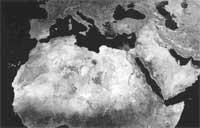Plastic trees for the Sahara
When the cold air front joins another hot air rains. This is a basic principle of meteorology and everyone knows. This is also the main reason that the Sahara is not as green as in other times.
The night humidity in the Sahara is barely kept by any organism. As soon as the sun rises, the night humidity evaporates sharply. How to store that water? There is the question.
To address the problem, the Spanish researcher Antonio Ibáñez Alba has proposed the use of plastic trees. They will be seven and ten meters high. The trunk will be made of polyurethane and the branches and leaves of phenolic foam. They will also have roots by injection of pressurized polyurethane into the soil sand. The roots of the trees can occupy an area of twenty meters of radius.

These first plastic trees prepared for the test are palm shaped and Ibáñez has analyzed them for four years in the laboratory.
Great changes occur in the desert from morning to 60ºC. Therefore, during the day the sun makes the plastic tree very hot and then at night that tree plays as a condensation trap. The plastic of the tree is specially prepared, with intermediate pipes to increase the capillarity, which allows to make water with the simple cooking of the trees. When the sun falls during the day, this water is released following the reverse procedure, but since the process is much longer, the accumulated water stays longer in it.
The emission of thousands of cubic meters of water vapor into the atmosphere will cause clouds to appear in large desert areas with thousands of plastic trees. This will make the climate stabilize and the changes are not so great. In addition, the clouds coming from the coast will have the opportunity to penetrate the interior of the Sahara and empty them with rain. On the other hand, as temperatures are not so high, the rain will not evaporate like now. Therefore, we can think that in ten years the Sahara can become fruitful.
One of the most important aspects of this system is the lack of irrigation of trees. The problem that has always existed in the actions that have been carried out to date for the regularization of drylands has been this: the initial irrigation of plants. Laborious and expensive work at all, as it is quickly spent on water and the consequences look much later.
Mauritania, Morocco, Algeria and Libya are interested in carrying out this project. In Libya, for example, plastic trees are placed between Sebha and Tripoli.
Buletina
Bidali zure helbide elektronikoa eta jaso asteroko buletina zure sarrera-ontzian











